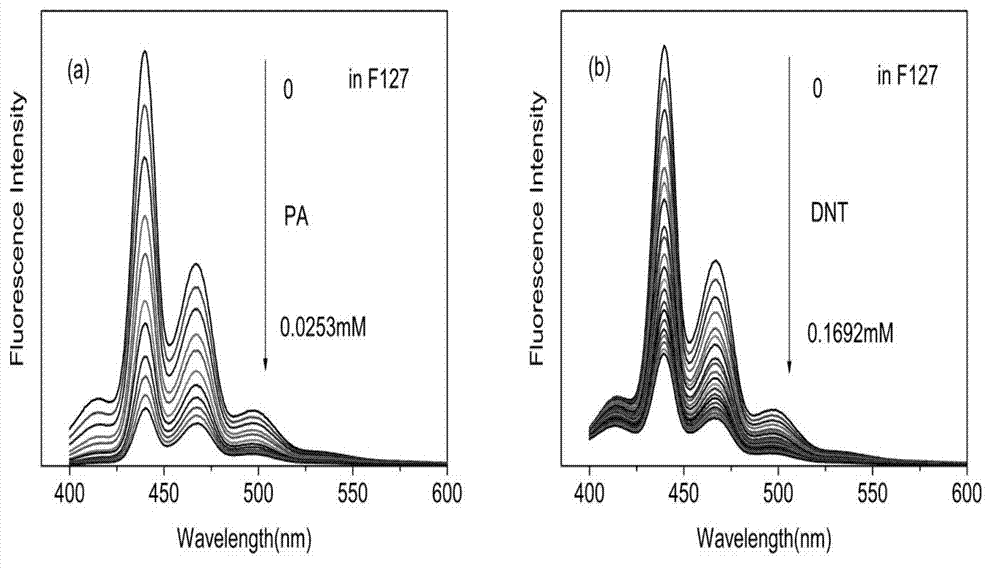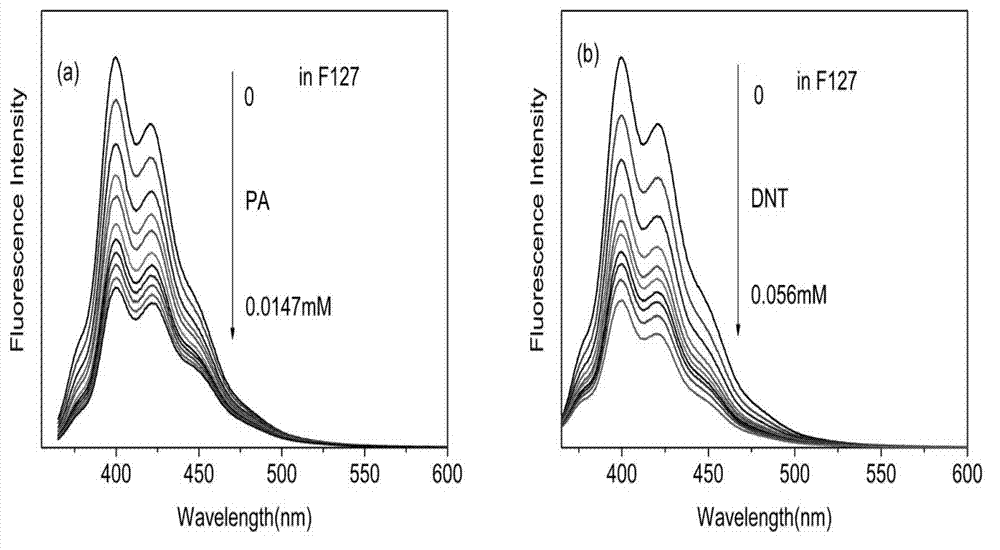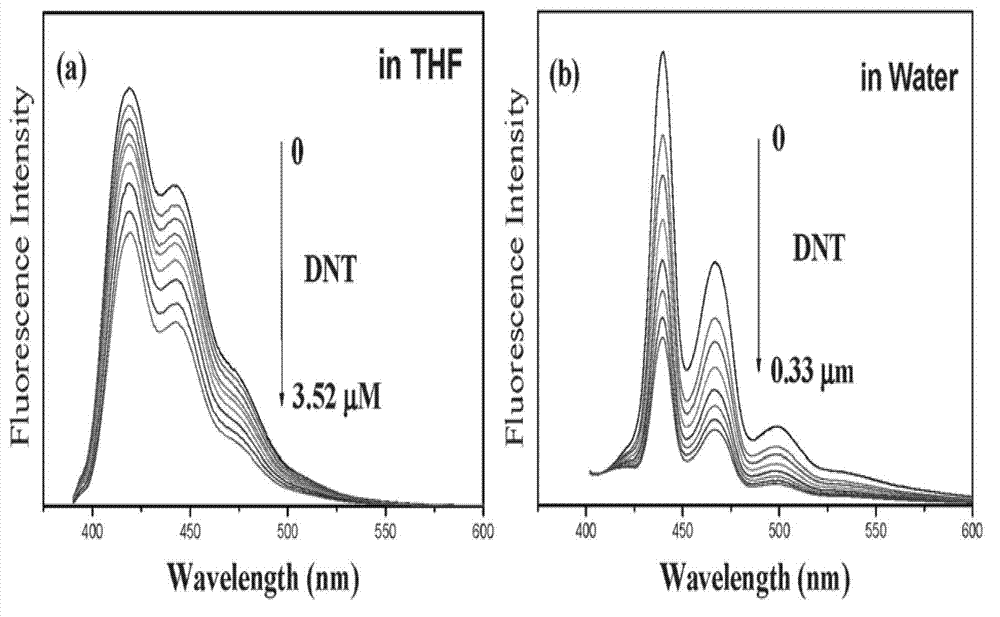Fluorescence-sensing-based method for rapidly detecting explosives such as nitrobenzene in water and applications thereof
A nitrobenzene-based, fluorescent sensing technology, applied in the fields of optics and polymer chemistry, can solve the problems of lack of rapid detection methods for explosive content, limit detection of explosives, increase detection costs, etc., and achieve simple and easy preparation process , good water solubility, and the effect of improving sensitivity
- Summary
- Abstract
- Description
- Claims
- Application Information
AI Technical Summary
Problems solved by technology
Method used
Image
Examples
Embodiment 1
[0040] (1) Preparation of polymer nanomicelle aqueous solution: disperse amphiphilic polymer F127 (purchased from Aldrich) in ultrapure water, stir magnetically for 30 minutes, and then sonicate for 1 hour to prepare a polymeric solution with a concentration of 0.01 mg / mL Object nano micellar aqueous solution;
[0041] (2) Preparation of fluorescent conjugated polymer solution: Dissolve fluorescent conjugated polymer 9,9-dioctylpolyfluorene (PFO) in tetrahydrofuran to prepare a fluorescent conjugated polymer solution with a concentration of 1 mg / mL;
[0042](3) Preparation of polymer micelle / conjugated polymer nanocomposite fluorescent probe: 50 μL of fluorescent conjugated polymer solution was added dropwise to the polymer nanomicelle aqueous solution under vigorous stirring, so that the mixed solution The total volume is 10ml; mix well by ultrasonication for 1 hour, remove tetrahydrofuran by rotary evaporation, replenish water to the volume before evaporation; filter with 0....
Embodiment 2
[0044] (1) Preparation of polymer nanomicelle aqueous solution: disperse amphiphilic polymer F127 (purchased from Aldrich) in ultrapure water, stir magnetically for 30 minutes, and then sonicate for 1 hour to prepare a polymeric solution with a concentration of 0.1 mg / mL Object nano micellar aqueous solution;
[0045] (2) Preparation of fluorescent conjugated polymer solution: Dissolve fluorescent conjugated polymer 9,9-dioctylpolyfluorene (PFO) in tetrahydrofuran, and prepare a fluorescent conjugated polymer solution with a concentration of 1 mg / mL;
[0046] (3) Preparation of polymer micelle / conjugated polymer nanocomposite fluorescent probe: 100 μL of fluorescent conjugated polymer solution was added dropwise to the polymer nanomicelle aqueous solution under vigorous stirring, so that the mixed solution The total volume is 10ml; mix well by ultrasonication for 2 hours, remove tetrahydrofuran by rotary evaporation, replenish water to the volume before evaporation; filter wit...
Embodiment 3
[0048] (1) Preparation of polymer nanomicelle aqueous solution: disperse amphiphilic polymer F127 (purchased from Aldrich) in ultrapure water, stir magnetically for 30 minutes, and then sonicate for 1 hour to prepare a polymer with a concentration of 1 mg / mL Nano micellar aqueous solution;
[0049] (2) Preparation of fluorescent conjugated polymer solution: Dissolve fluorescent conjugated polymer 9,9-dioctylpolyfluorene (PFO) in tetrahydrofuran, and prepare a fluorescent conjugated polymer solution with a concentration of 1 mg / mL;
[0050] (3) Preparation of polymer micelle / conjugated polymer nanocomposite fluorescent probe: 1000 μL of fluorescent conjugated polymer solution was slowly added dropwise to the polymer nanomicelle aqueous solution under vigorous stirring to make the mixed solution The total volume of the solution is 10ml; mix well by ultrasonication for 4 hours, remove THF by rotary evaporation, and replenish water to the volume before evaporation; filter with a 0...
PUM
| Property | Measurement | Unit |
|---|---|---|
| Concentration | aaaaa | aaaaa |
| Particle size | aaaaa | aaaaa |
| Particle size | aaaaa | aaaaa |
Abstract
Description
Claims
Application Information
 Login to View More
Login to View More - R&D
- Intellectual Property
- Life Sciences
- Materials
- Tech Scout
- Unparalleled Data Quality
- Higher Quality Content
- 60% Fewer Hallucinations
Browse by: Latest US Patents, China's latest patents, Technical Efficacy Thesaurus, Application Domain, Technology Topic, Popular Technical Reports.
© 2025 PatSnap. All rights reserved.Legal|Privacy policy|Modern Slavery Act Transparency Statement|Sitemap|About US| Contact US: help@patsnap.com



